- MENU
- HOME
- SEARCH
- WORLD
- MAIN
- AFRICA
- ASIA
- BALKANS
- EUROPE
- LATIN AMERICA
- MIDDLE EAST
- United Kingdom
- United States
- Argentina
- Australia
- Austria
- Benelux
- Brazil
- Canada
- China
- France
- Germany
- Greece
- Hungary
- India
- Indonesia
- Ireland
- Israel
- Italy
- Japan
- Korea
- Mexico
- New Zealand
- Pakistan
- Philippines
- Poland
- Russia
- South Africa
- Spain
- Taiwan
- Turkey
- USA
- BUSINESS
- WEALTH
- STOCKS
- TECH
- HEALTH
- LIFESTYLE
- ENTERTAINMENT
- SPORTS
- RSS
- iHaveNet.com: Health
Sue Hubbard, M.D.

Migraine headaches seem to run in families
Headaches are a common complaint throughout childhood, but pediatricians have recognized that children have many different types of headaches, including migraines. Migraine headaches are best diagnosed by obtaining a detailed history and then a thorough neurological exam.
There are several characteristics of childhood migraines that are quite different than adult migraines. While adult females have a higher incidence of migraine headaches, males predominate in the childhood population.
Childhood migraines often are shorter in duration than an adult migraine and are less often unilateral (one-sided) than in adults. Only 25-60 percent of children will describe a unilateral headache, while 75-90 percent of adults have unilateral pain.
Children do not typically have visual auras like adults, but may have a behavioral change with irritability, pallor, malaise or loss of appetite proceeding the headache. About 18 percent of children describe migraine with an aura and another 13 percent may have migraines with and without auras at different times.
When taking a history, it's also important to ask about family history of migraines, as migraine headaches seem to run in families. Children who develop migraines were also often noted to be "fussy" infants, and they also have an increased incidence of sleep disorders, including night terrors and nightmares. Many parents and children also report a history of motion sickness.
When children discuss their headaches, they often complain of feeling dizzy (which actually sounds more like being light-headed than vertigo on further questioning). They may also complain of associated blurred vision, abdominal pain, nausea and vomiting, chills, sweating, or even feeling feverish. A child with a migraine appears ill, uncomfortable and pale, and will often have dark circles around their eyes.
It seems that migraine headaches in childhood may be precipitated by hunger, lack of sleep and stress. But stress for a child may be positive, like being excited, as well as typical negative stressors.
Children will also tell you that their headaches are aggravated by physical activity, such as going up and down stairs, carrying a backpack, or even just bending over. They may complain of photophobia (light sensitivity) and phonophobia (sensitive to noises) and typically a parent will report that their child goes to bed in a dark room or goes to sleep when experiencing these symptoms. Children with migraines don't watch TV or play video games during their headaches. They are quiet, may not want to eat, and may just want to rest. Nothing active typically "sounds" like fun.
To meet the diagnostic criteria for childhood migraine, a child needs to have at least five of these "attacks. A headache log is helpful, as these headaches may occur randomly and it's difficult to remember what the headache was like or how long it lasted without keeping a log.
There are many new drugs available for treating childhood migraines that I'll discuss in another column dose. Stay tuned!
Dr. Sue Hubbard is a nationally known pediatrician and co-host of "The Kid's Doctor" radio show.
Available at Amazon.com:
Copyright © KIDSDR.COM DISTRIBUTED BY TRIBUNE MEDIA SERVICES, INC.
AGING | ALTERNATIVE | AILMENTS | DRUGS | FITNESS | GENETICS | CHILDREN'S | MEN'S | WOMEN'S
Health - Children Can Have Migraine Headaches